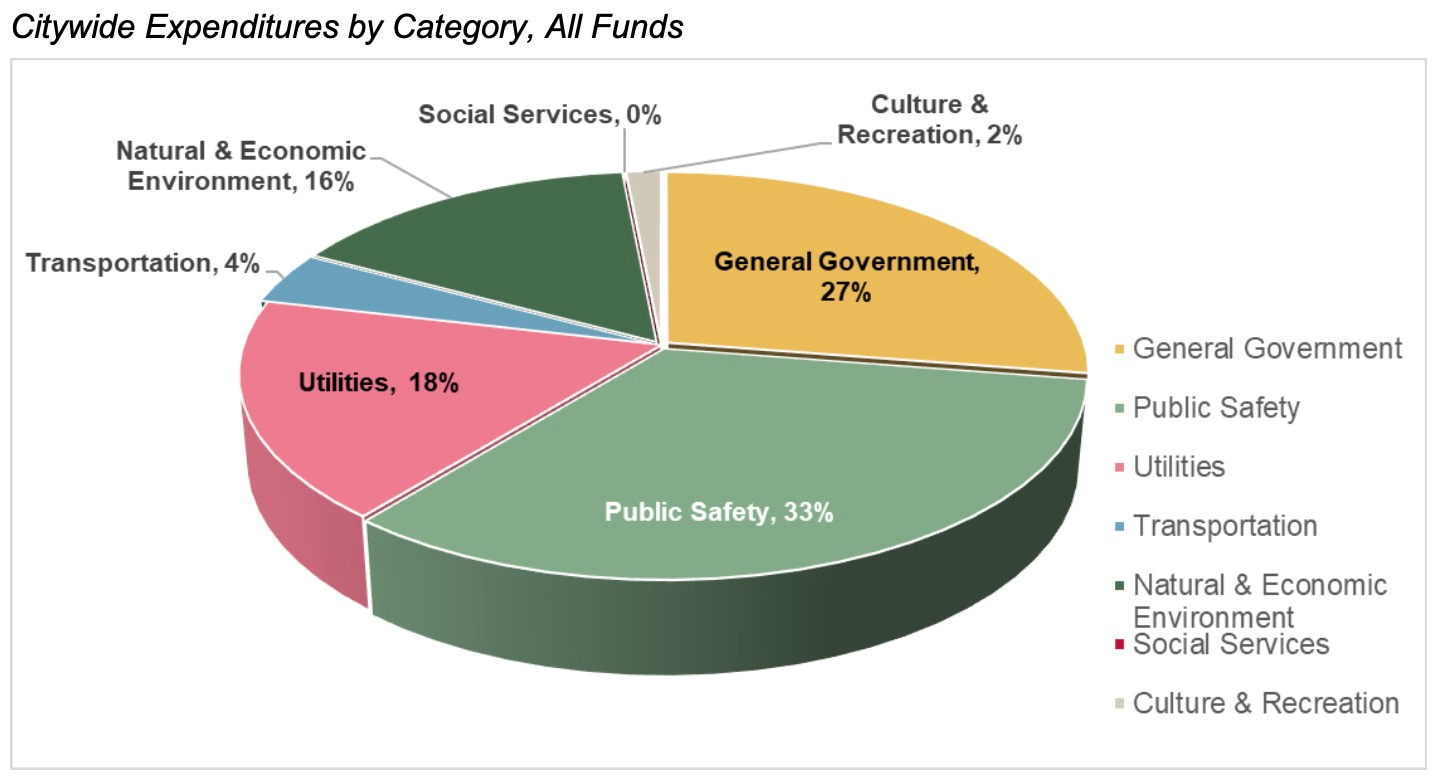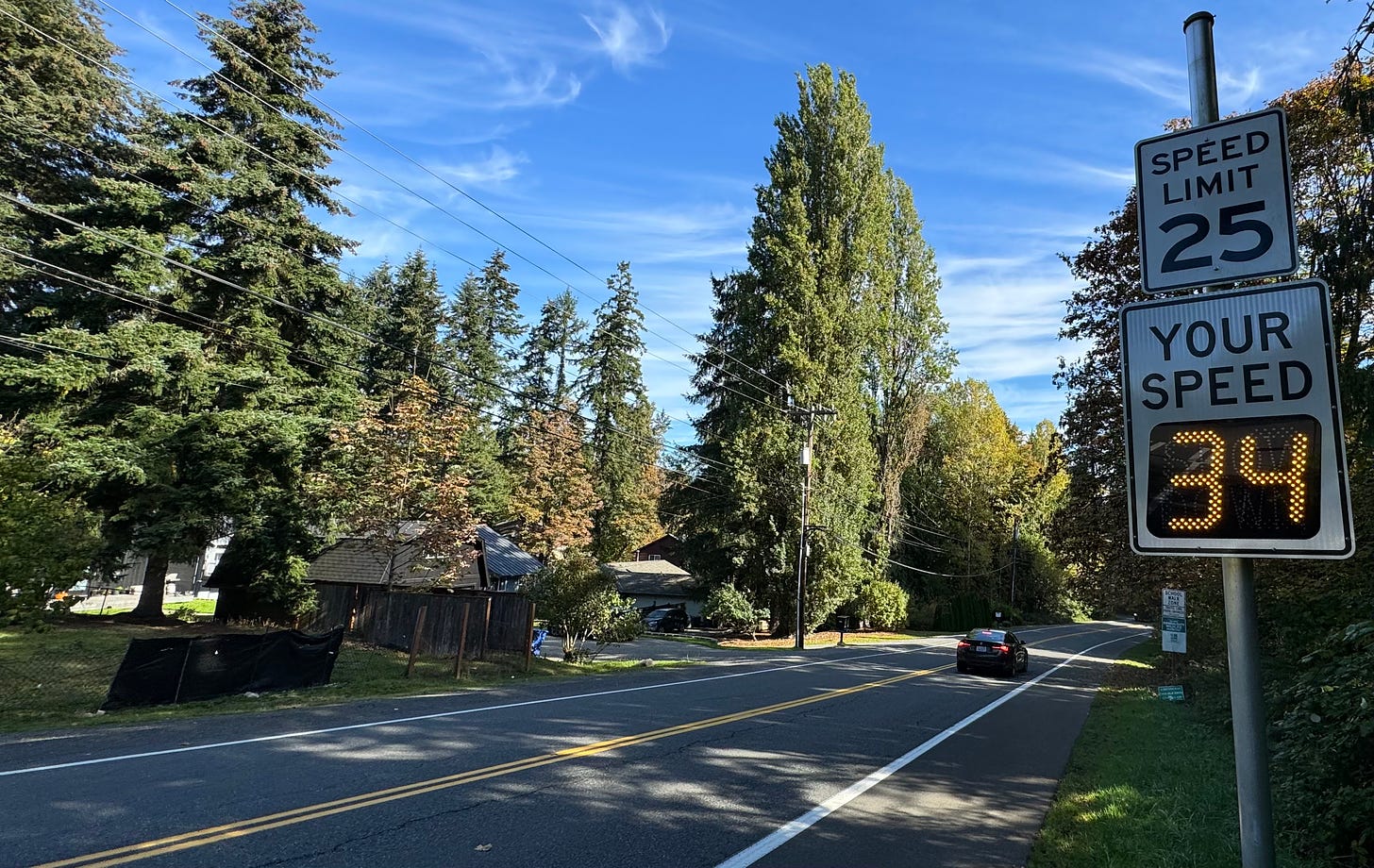Cameras may fund traffic safety in Lake Forest Park despite $3 million deficit
LFP expects a $3 million deficit for the 2025-2026 biennium but millions from traffic cameras could pay for sidewalks and traffic safety.
In his budget for the 2025-2026 biennium, Mayor Tom French said Lake Forest Park will have a $1.5 million deficit each year over the next two years. But revenue from traffic cameras could build sidewalks across the city. City staff said the deficit was “largely due to the state’s 1% cap on property taxes and 3% inflation on average.” Compared to neighboring cities, Lake Forest Park has lower property taxes and collects less revenue from real estate construction.
Lake Forest Park’s budget deficit predates recent high inflation rates: the 2019-2020 budget had a deficit of $877,000, then a deficit of $1.25 million in the 2021-2022 biennial budget, and a $1.9 million deficit in the 2023-2024 budget. But now with rising expenses for police compensation, public defenders, jail services, and 911 dispatch the city expects a $3 million deficit for the 2025-2026 budget.
Lake Forest Park voters have repeatedly rejected past city property tax increases by wide margins. A levy to pay for parks and sidewalks on the 2021 ballot was rejected by over 65% of Lake Forest Park voters and a 2010 property tax levy was rejected by 77.97%. Although a fire levy lift in August this year was approved by 67.38% of Lake Forest Park voters preventing what Fire Chief Cowan called a “critical” budget imbalance.
Lake Forest Park expects to collect $7,161,227 in property taxes over the next two years. In 2024, Lake Forest Park collected about $0.80 for every $1000 of a home’s assessed value (AV). The median-priced-home in Lake Forest Park was assessed at $790,000 which means a median-priced-homeowner paid roughly $635.39 in property taxes to the city. In contrast, a median-priced-homeowner in Shoreline paid a little over $1200 and Kenmore charged a little over $821 in 2024.
At the Thursday October 10 meeting the Lake Forest Park city council discussed hiring an outside consultant to help the city prepare a possible levy lid lift to put on the ballot next year. In a job post for the external consultant, the city said it is facing a “structural financial deficit” and was considering placing a levy on the 2025 ballot.

The city collects less revenue from real estate taxes and construction fees compared to neighboring cities and Lake Forest Park’s draft comprehensive plan says its strict zoning laws are a barrier to affordable housing development. Lake Forest Park expects only $650,000 from Real Estate Excise Taxes (REET) during the next biennium while Kenmore expects $3.5 million from REET over the next two years and Shoreline collected $3.49 million in REET over the last two years despite a cooling real estate market.
Shoreline last month reported stronger than planned revenues driven in part from taxes and fees from multifamily housing construction near the new light rail stations. Kenmore has $10.4 million in its general fund reserves (well above the $3.3 million required) which staff attributed in part to taxes and fees received from real estate developments such as the new condominiums downtown.
Public Safety is Lake Forest Park’s largest spending category at 33% of the 2025-2026 budget (costing $15,257,380). Most of that will go to the Lake Forest Park police department. Police salaries have increased by 13.6%, 911 dispatch services have increased by 41.5%, and the city is expecting to pay more than twice as much to jail its prisoners. Municipal court costs are up 7.5% and the city will pay 13.6% more for its public defenders. Those costs could increase even more if the Washington Supreme Court approves a proposal from the Washington State Bar Association to reduce public defender case loads to address a “crisis of attrition”.

The city expects to collect $12 million in traffic safety camera fines over the next biennium thanks to a new state law that allowed the city to increase fines and leave the cameras on all-day throughout the year after designating 178th near Brookside elementary a “school walk zone.” The old red-light cameras along Bothell Way and the speed cameras near Lake Forest Park elementary will bring $4,381,800 and the city expects its “New Traffic Safety Fund” to earn $8,040,000 from the cameras on 178th near Brookside elementary.
Traffic camera operating costs have increased from $765,000 last biennium to $2,326,440 in part because the city will hire an additional police officer, a support officer, and two court clerks to keep up with the work of processing tickets. In August, Municipal Court Judge Jennifer Grant cautioned the city about the workload caused by more than 23,000 traffic camera tickets last year. “Each and every one of those tickets does amount to a significant amount of work,” said Judge Grant.
The city is keeping revenue from the old cameras and the new cameras separate because the new state law requires the city to now spend funds on traffic safety improvements after paying operating costs (the city was previously allowed to deposit the revenue into the general fund). The budget does not specify which traffic safety projects would be funded with the millions expected each year. The levy for parks and sidewalks that voters rejected in 2021 would have collected about $2 million annually to pay for a network of sidewalks across the city - especially near schools.
So maybe pedestrians in Lake Forest Park will get sidewalks after all.



